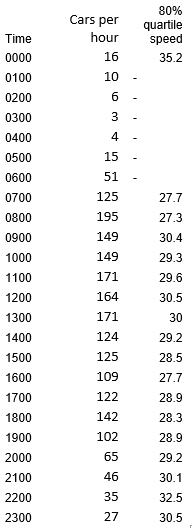The latest information on the Cycle Enfield website about Enfield Council's Quieter Neighbourhoods programme outlines an updated strategy, which envisages schemes eventually covering the entire borough. It introduces the concept of "low-traffic neighbourhoods" and lists new planned QNs to be created during phases 2 to 4 of the programme, including, for the first time, a scheme in Bowes ward west of Green Lanes.
Revised proposals for the Fox Lane and Connaught Gardens schemes, which are included in phase 1, will be revealed at public events in, respectively, "late summer 2019" and "early Autumn 2019".
 "Ambitious vision"
"Ambitious vision"
The update on Quieter Neighbourhoods was published on the main Quieter Neighbourhoods page of the Cycle Enfield website in early August. It outlines an "ambitious vision to see Quieter Neighbourhoods across the borough", requiring a "long-term commitment and programme of work" and aligned with the Mayor of London's Transport Strategy 2018, which aims to achieve 80 per cent of trips by walking, cycling or public transport by 2041. The page lists eight QNs, to be implemented in four phases (see the table further down the page), which should be "substantially delivered" by 2022, to be followed by further schemes.
The remainder of this article summarises and comments on some of the information on the web page, but is not comprehensive and no substitute for reading the full update.
"Low-traffic neighbourhoods"
The introductory overview states that "The ambition of the Council is to adopt a ‘Low Traffic Neighbourhood’ approach, where ‘through’ motor vehicle traffic is discouraged or removed. Individual area feasibility studies will explore the measures that could be considered." The aims of this approach include improving the liveability, amenity and safety of Enfield neighbourhoods, and making it possible for people to walk and cycle safely from their front door to connect with public transport options and/or major walking and cycling routes.
The choice of the phrase "low-traffic neighbourhood" is significant, as this is the term used to describe a concept developed jointly by campaigning groups London Living Streets and the London Cycling Campaign in 2018. In such a neighbourhood it is possible to drive to or from every address, but strategically placed "filters" (typically, bollards) make it impossible to cut through the neighbourhood by car. The filters do not impede people on foot or riding bikes. Several low-traffic neighbourhoods have been created in Waltham Forest and have transformed once noisy and hazardous streets into zones of calm and peace.
Whether or not this is how Enfield Council are using the term is unclear. Two of the schemes in Phase 1 - the recently implemented Fernleigh Road measures and the published proposals for Connaught Gardens - both allow traffic to drive through the areas. In particular, the Connaught Gardens scheme does absolutely nothing to tackle high volume rat-running between Hedge Lane and the North Circular along Connaught Gardens, Hazelwood Lane, Chimes Avenue, Arnold Gardens and Callard Avenue. That said, after the failure of the "planters" scheme to reduce traffic volumes and speeds, quieter streets campaigners are eagerly awaiting the new proposals for the Fox Lane neighbourhood, anticipating that they will create a true LTN. These proposals are due to be unveiled in "late summer".
Stages
Individual QN schemes will be developed and implemented in six (or seven) stages. Phase 1 schemes will already have passed through some stages (see the table).
- Stage 1 – ask residents to share their ideas on problems and potential solutions in their area.
- Stage 2 – the Council will review these ideas and develop some plans.
- Stage 3 – the Council will host a public event to explain the plans and provide an opportunity for residents to comment.
- Stage 4 – The Council will then conduct a further review of the plans.
- Stage 5 – A period of statutory consultation and/or a trial will take place.
- Stage 6 – Decisions and implementation of the plans in a particular area.
- Stage 7 – where appropriate, monitor and review post implementation.
The following table summarises scheduling information derived from the Quieter Neighbourhoods web page. (If the table does not display properly, click here.)
| Stages | Phase 1 | Phase 2 | Phase 3 | Phase 4 | ||||
| Fox Lane | Connaught Gardens | Fernleigh Rd | Bowes | Bush Hill Rd | Firs Lane | Edmonton | A1010 North | |
| 1 - resident input | Late Summer 2019 | Late Summer 2019 | Late Summer 2019 | Spring 2020 | Autumn 2020 | |||
| 2 - plans developed | Currently | |||||||
| 3 - public event and feedback | Late Summer 2019 | Early Autumn 2019 | ||||||
| 4 - further review | ||||||||
| 5 - statutory consultation and/or trial | ||||||||
| 6 - decide and implement | End 2019 | |||||||
| 7 - monitor and review | ||||||||
Individual QNs
Connaught Gardens: "A series of initial width restrictions have already been implemented in this area, but a further series of measures were originally proposed. These have been reviewed in light of the Fox Lane experiences. This project will continue at Stage 3, which is currently scheduled for early Autumn 2019."
The "further measures" are presumably those shown on the map in this September 2017 report. The council has never published the responses to the 2017 consultation. So far only the two width restrictions at the Hedge Lane ends of Connaught Gardens and Munster gardens have been implemented, to block access to HGVs, but most rat-running is done by cars, not lorries. The one-way scheme in the top right-hand corner of the map was probably opposed by residents concerned that traffic would be diverted onto their streets (eg Park Avenue). Hopefully, the review that is referred to will come up with a more effective scheme to tackle the chronic rat-running through this area.
Fernleigh Road: As reported on Palmers Green Community in August 2018 and on the Cycle Enfield website, the Fernleigh Road proposals were significantly watered down following the consultation. The work has been complete for several months, but one aspect of it, the point no entry in Stonard Road, is still being trialled. A decision is expected in December.
Bowes: "Although in phase 2, a series of initial steps have already been taken for the Bowes area, which include a width restriction on Warwick Road and Controlled Parking Zone (CPZ proposals). In addition, a further study is in progress which is a collaboration between TfL, Enfield and Harringay, which is focussed on Palmerston Road, but is considering the wider area. The Quieter Neighbourhood work will build on this work and consider the feasibility of introducing low traffic neighbourhood zones within the area. Whilst a series of issues are already well known, in order to ensure everyone in the community has the opportunity to comment, we will conduct Stage 1 of this project which is expected late Summer 2019. The programme will then be developed further."
The part of Bowes ward west of Green Lanes has not previously been included in any quieter neighbourhood schemes, but it is clear from ward forum meetings that there is great concern about traffic levels. Warwick Road and Brownlow Road are particularly affected. A new width restriction has solved the problem of HGVs using Warwick Road as a cut-through, but it is still very busy with cars. Brownlow Road is horrendously busy with regular long tailbacks from the lights at the North Circular. Palmerston Road is theoretically a "quietway" for cycles, but is anything but quiet.
Links
Quieter Neighbourhoods page on Cycle Enfield website with outline of new strategy
Previous Palmers Green Community reporting on Quieter Neighbourhoods
Enfield Council will create low traffic neighbourhoods (Better Streets for Enfield)
The whys and wherefores of Low Traffic Neighbourhoods (Palmers Green Community)






